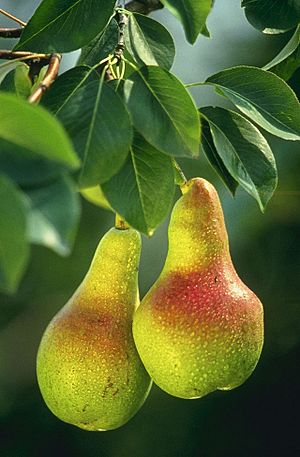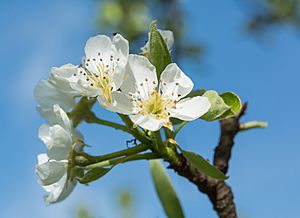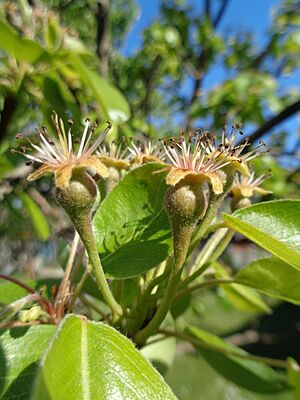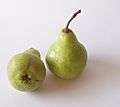Common pear facts for kids
Quick facts for kids Common pear |
|
|---|---|
 |
|
| Common pear branch with fruit | |
| Conservation status | |
| Scientific classification | |
| Genus: |
Pyrus
|
| Species: |
communis
|
| Synonyms | |
|
List
|
|
The common pear, known scientifically as Pyrus communis, is a type of pear tree. It originally grew in central and eastern Europe, and western Asia. This tree is very important for its fruit in many parts of the world.
Most of the pear varieties grown in Europe, North America, and Australia come from this species. In East Asia, other pear types like the Nashi pear (Pyrus pyrifolia) and the Chinese white pear (Pyrus × bretschneideri) are more popular.
Where Pears Come From
The common pear we eat today (P. communis subsp. communis) likely came from two types of wild pears. These are P. communis subsp. pyraster and P. communis subsp. caucasica. These wild pears can still breed with the pears we grow.
People have been gathering wild pears for a very long time. Evidence shows pears were collected in Europe during the Neolithic (New Stone Age) and Bronze Age. We know for sure that people started growing pears in the times of Ancient Greece and Ancient Rome. Writers like Theophrastus and Pliny the Elder wrote about how to grow and graft pear trees. Grafting is a way to join parts of two plants so they grow as one.
Growing Pear Trees
Common pear trees are almost as tough as apple trees. However, they need a cold winter period to produce fruit. This cold time helps the tree get ready to bloom and make pears. Many types of caterpillars like to eat the leaves of pear trees.
For the best fruit, common pears are picked when they are mature but not yet fully ripe. If pears ripen on the tree, they often fall off and can get bruised. Pears can be stored and shipped well when they are mature but unripe, especially if kept cold. They can then be ripened later. This process is called bletting. Some pear types, like 'Beurre d'Anjou', only ripen after being exposed to cold.
A drink called perry is made from fermented pear juice. In Britain, some place names like "Perry" might mean that pear trees once grew there.
Only a small number of pear varieties are grown widely around the world. About 20-25 European types and 10-20 Asian types make up almost all the pears sold today. Most European varieties came from chance seedlings found in western Europe, especially France. Asian varieties came from Japan and China. The 'Bartlett' pear (also called 'Williams') is the most common pear variety globally. It makes up about 75% of pear production in the US.
Popular Pear Varieties
In the United States, most pears grown in 2004 came from just a few types:
- Williams' Bon Chrétien: This pear started in England around 1770. It's a summer pear often called 'Bartlett' in the US and Canada.
- Beurré d'Anjou: From France, this is a winter pear often called 'd'Anjou'.
- Beurré Bosc: Also from France, this winter pear is known as 'Bosc' or 'Kaiser'.
- Doyenné du Comice: This pear came from France in 1849 and is often called 'Comice'.
Some other well-known pear varieties include:
- Abate Fetel: A very important pear in Italy.
- Concorde: From England, this pear is a mix of 'Conference' and 'Doyenné du Comice'.
- Conference: Also from England, this is the most popular pear grown for sale in the UK.
- Packham's Triumph: This pear came from Australia in 1896.
- Red Bartlett: These are red-skinned versions of the 'Bartlett' pear.
- Seckel: An old variety from the US that is naturally good at resisting a plant disease called fireblight.
- Starkrimson: A red-skinned pear with smooth, bright red skin and sweet, creamy fruit.
Images for kids
See also
 In Spanish: Peral para niños
In Spanish: Peral para niños






















